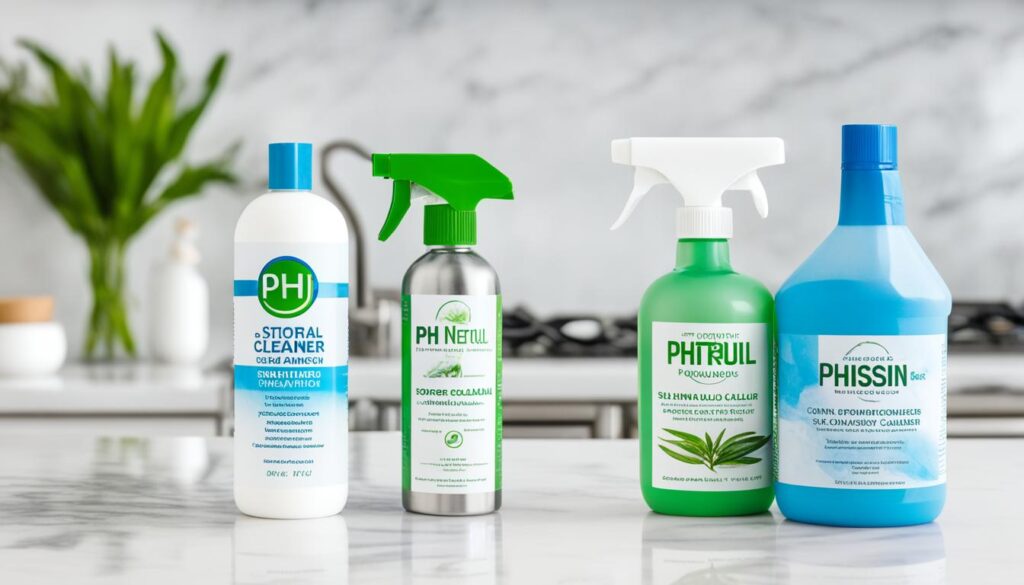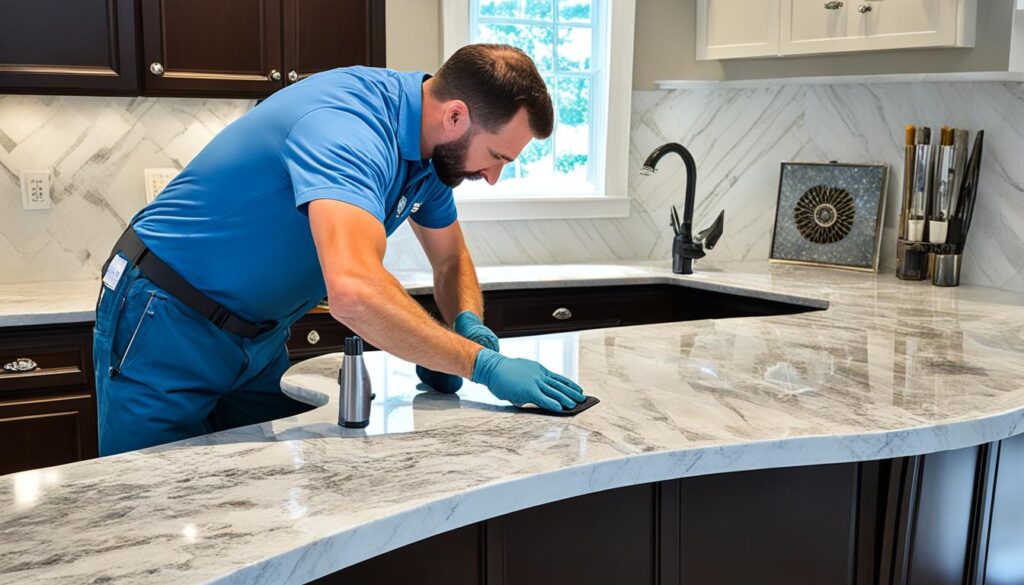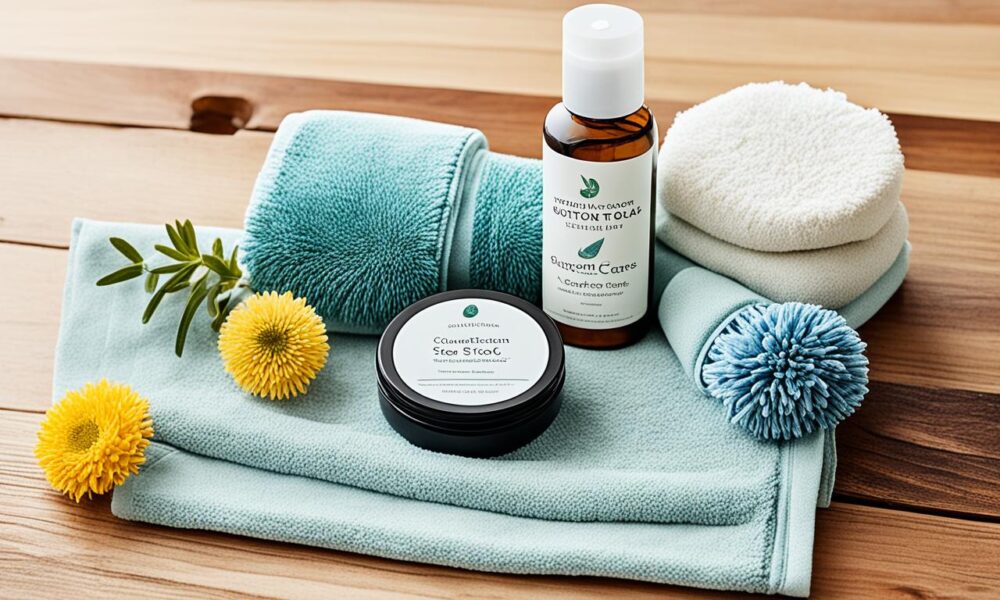Natural Stone Care and Maintenance Guide
Embracing the elegance of natural stone creates an air of sophistication and durability in any space. To ensure these stone surfaces retain their pristine condition—whether they grace your countertops, floors, or walls—a conscientious approach to natural stone care is indispensable. It’s not merely about cleaning stone countertops or maintaining stone surfaces; it’s about preserving the heritage and beauty that have made these materials the cornerstone of architectural design.
Delving into the world of stone surface maintenance doesn’t have to be daunting. This guide unveils the essential practices on How to Care for and Maintain Your Natural Stone Surfaces, offering a straightforward pathway to protect your investment. The rich textures and hues of your stone selection—when nurtured with knowledge and attention—can be a source of joy for years to come.
Key Takeaways
- Understanding the unique needs of each stone type is crucial for proper maintenance.
- Regular cleaning with pH-neutral stone cleaners preserves stone integrity.
- Immediate spill management prevents stains and sustains stone beauty.
- Sealing stone surfaces is a pivotal step in guarding against potential damage.
- Professional assessments for stone restoration can enhance longevity.
- Incorporate stone-specific poultices cautiously to address deep-set stains.
Understanding Your Natural Stone
The journey to preserving the natural charm of your stone begins with grasping its geological classification of natural stone. Whether you are caring for marble and granite or any other type of stone, recognizing whether your stone is of the Sedimentary, Metamorphic, or Igneous variety is fundamental. This determines not just its aesthetic allure but also dictates the specificity of its care.
While Sedimentary stones have formed through the accumulation of sediments, Metamorphic stones have been transformed through extreme pressure and heat, and Igneous stones have solidified from molten lava. Furthermore, familiarizing yourself with whether you have Calcareous stone, like limestone or marble, composed mostly of calcium carbonate, or Siliceous stone, such as granite or sandstone, composed of silicates, is paramount.
Why does this distinction matter? Because the very nature of the stone’s composition influences its resilience to acidic solutions and dictates the type of care it necessitates. It’s not just about keeping the surfaces visually pleasing; it’s about employing the right methods to ensure their longevity. Let’s consider this essential contrast in stone types with the following table:
| Stone Classification | Description | Composition | Characteristic Care |
|---|---|---|---|
| Calcareous Stone | Composed of calcium carbonate, sensitive to acid | Marble, Limestone | Use mild, non-acidic cleaners |
| Siliceous Stone | Composed mainly of silicates like quartz | Granite, Quartzite | Generally acid-resistant, but still avoid harsh cleaners |
| Sedimentary | Formed from accumulated sediments | Travertine, Sandstone | Clean gently and seal appropriately |
| Metamorphic | Transformed by heat and pressure | Slate, Schist | May require specific polishing techniques |
| Igneous | Formed from cooling lava | Basalt, Granite | Durable but benefit from periodic sealing |
By understanding the geological formations—Sedimentary, Metamorphic, and Igneous—and whether a stone is Calcareous or Siliceous, not only can we tailor our cleaning protocols but also preemptively defend against potential damage. Caring for marble and granite or any stone, therefore, becomes more than routine—it becomes a specialized practice to safeguard the stone’s inherent qualities.
- For Calcareous stones, avoid any acid-based cleaning agents that could etch or dull the finish.
- Siliceous stones, while more robust, still require gentle, non-abrasive cleaners to maintain their polish and longevity.
- Regardless of stone type, regular sealing is recommended to enhance resistance to wear and tear.
The convergence of beauty and durability in natural stone is not coincidental. It is the result of arduous geological processes coupled with meticulous human care. Knowing the delicate balance between the two encourages practices that not only clean but also honor the geological character of natural stone.
How to Care for and Maintain Your Natural Stone Surfaces
Maintaining the elegance of natural stone surfaces requires dedicated techniques tailored to preserve their unique beauty. From luxurious marble to enduring granite, each type has its own set of care protocols that are essential for prolonging their life and luster. In this section, we’ll explore specialized cleaning methods, spill and stain prevention strategies, and the vital role of sealants in safeguarding these exquisite surfaces.
Cleaning Techniques for Different Stone Types
Implementing proper stone surface care techniques starts with the right cleaning agents. For day-to-day maintenance, neutral pH cleaners for stone are recommended as they are gentle yet effective, ensuring the longevity of the sealant and protection of the stone. To tackle tougher grime, heavy-duty stone cleaners formulated for deep cleaning natural stone can penetrate and remove stubborn dirt without causing damage. A soft bristle brush can agitate the surface mildly, and it’s crucial to dry the stone thoroughly, preventing potential watermarks or lingering stains.
Here’s a brief outline of care for different stone types:
- For calcareous stones such as marble and limestone, use specific stone soap that won’t harm their delicate surfaces.
- Siliceous stones like granite can withstand more rigorous cleaning, but still benefit from pH-neutral solutions.
- Unique textures like those of travertine may require bespoke cleaning regimens.
Best Practices for Spill and Stain Prevention
When an accidental spill occurs, swift action is your first line of defense in stain removal from natural stone. It’s imperative to blot spills immediately with a clean cloth to prevent them from setting in. For stubborn stains, a poultice for natural stone may be applied to draw out the discoloration. It’s important to note that while poultices are effective for pulling out stains, they may dull the polished finish of the stone, which can then be rebuffed to restore its original sheen.
Preventative measures also play a significant role in preserving natural stone. Simple habits like utilizing coasters, mats, and placemats can go a long way in keeping your stone pristine. Addressing spillages promptly ensures that your cherished stone surfaces remain spotless and protected.
Sealing Your Stone for Long-Term Protection
The process of sealing natural stone serves as a barrier against potential stains and damage. Selecting a high-quality impregnating sealer for stone post-installation creates an effective shield that embeds within the pores of the stone. Depending on daily use and exposure, this sealing should be redone periodically, based on manufacturer’s guidelines.
Specific stone enhancers can also be utilized to accentuate the natural hues of the stone, adding a layer of stone protection while highlighting its inherent beauty. Whether you’re opting for a penetrating sealer that maintains the stone’s original finish or an enhancing sealer that deepens its tones, meticulously following application instructions is paramount for securing maximum efficacy.
By integrating these stone surface cleaning tips into your regular maintenance schedule, you ensure that your natural stone surfaces will not only clean but flourish in their original splendor for the years to come.
Routine Stone Care and Cleaning Tips
Adopting a regular dust mopping natural stone routine is crucial in protecting the stone’s delicate surface from abrasive particles. This simple act of maintenance can significantly extend the life and maintain the beauty of your stone surfaces. To facilitate effective stone care, one must choose appropriate cleaning products for stone care that align with the composition and resilience of the stone in question.
Avoiding scratches and etching means circumventing the use of acidic products that are not specifically formulated for natural stone applications. Non-acidic cleaning solutions provide a safe alternative for stone, preserving the integrity of the stone’s surface and ensuring that the sealants remain effective over time.
Effective stone care also involves using protective barriers such as rugs and mats to trap dirt and sand, particularly in high traffic areas. These simple additions not only contribute to the aesthetic of a space but serve the practical function of minimizing the everyday wear on the stone surfaces beneath.
When spillages do occur, the key is to address them immediately with soft cloths and non-acidic cleaning solutions for stone, which help maintain the stone’s pristine state. Let’s delve into a preventative maintenance routine that can keep your natural stone in top condition.
- Daily Dust Mopping: Gently sweep stone floors with a non-treated, dry dust mop to remove debris.
- Weekly Damp Mopping: Use a damp mop with a pH-neutral cleaner designed for natural stone.
- Spill Response: Blot up spills immediately with a soft cloth, then clean with a neutral cleaner and dry the area thoroughly.
- Protective Measures: Place mats or rugs at entrances to reduce the amount of dirt and grit reaching the stone surfaces.
| Type of Stone | Recommended Cleaning Products | Frequency of Cleaning | Special Considerations |
|---|---|---|---|
| Marble | Non-acidic, pH-neutral cleaner | Daily to weekly, depending on usage | Use coasters for drinks; wipe up acidic spills immediately |
| Granite | Mild detergent or stone soap | Weekly, or as spills occur | Trivets for hot items; avoid abrasive pads |
| Limestone | Non-acidic, pH-neutral cleaner | Regularly, in line with foot traffic | Seal periodically to guard against stains |
| Travertine | Mild, pH-neutral cleaner | As needed, especially after heavy use | Fill any pits or voids that collect debris |
| Slate | Diluted, pH-neutral liquid soap | Bi-weekly, or as dust accumulates | Avoid pooling water; seal to enhance natural color |
The systematic care of natural stone is a marriage of gentle, yet effective practices that stone care essentials offer. This collaboration of suitable products and strategic practices ensures that your stone surfaces remain an emblem of natural elegance and functionality in your living space.

Professional Techniques for Stone Surface Maintenance
For homeowners and property managers vested in maintaining stone surfaces, understanding when and how to apply professional techniques can make all the difference. Knowing whether to treat at home or call in an expert stone care professional is key to preserving the beauty and integrity of stone surfaces.
When to Call in the Pros: Damage and Restoration
Sometimes, despite our best efforts, stone surfaces can sustain damage that goes beyond the scope of routine cleaning and care. In such instances, professional stone restoration becomes an indispensable service. Be it a profound etch on a marble vanity, a chip on a granite countertop, or a crack in a travertine tile, these forms of damage require the skilled hand of a restoration expert. These technicians bring to the table advanced techniques and materials designed specifically for damage repair for stone surfaces, ensuring that repairs are not only effective but also aesthetically in tune with the rest of the stone’s surface.
It is recommended to seek a restoration expert when:
- The damage is structural, such as cracks that compromise the integrity of the stone
- There are deep or wide stains that do not respond to normal stain removal methods
- The shine or finish of the stone has been marred due to heavy traffic or chemical exposure
Evaluating Stone Enhancers and Impregnating Sealers
Sealants play a pivotal role in maintaining stone surfaces. When selecting impregnating sealers, it is essential to understand their function and benefits. These products penetrate the stone’s porous surface, creating a barrier against moisture and stain penetration, while stone enhancers not only protect but also serve to highlight and intensify the stone’s natural color.
The right sealer can:
- Provide a strong protective layer against spills and wear
- Extend the life of the stone by reducing porosity and vulnerability to staining
- Enhance the natural beauty of the stone, making colors more vibrant
When evaluating stone sealers, consider:
- The location of the stone (indoor or outdoor)
- The level and types of exposure to elements and foot traffic
- The desired finish, whether it be natural, enhanced, or glossy
Following the manufacturer’s instructions for application and evaluating stone sealers based on the specific stone and setting guarantees that not only will the beauty of the stone be preserved, but also its robustness for future generations to enjoy.

In conclusion, the intricacies of stone care are manifold, but with a blend of routine maintenance and professional insight when necessary, natural stone will continue to be one of the most revered and reliable materials in the construction of beautiful spaces. Whether opting for DIY upkeep or enlisting professional assistance for damage repair for stone surfaces, each step contributes to a lasting legacy of natural beauty and integrity.
Special Considerations for Stone Varieties
Maintaining the timeless allure of natural stone surfaces demands an understanding of their unique characteristics. In the universe of natural stone varieties, calcareous and siliceous stones are broadly classified based on their mineral compositions and reactivity to chemicals. These differences are what dictate distinct maintenance needs, which when carefully adhered to, can significantly enhance their durability and elegance. The following considerations can ensure long-term sustainability for these treasured surfaces.
Calcareous vs. Siliceous Stones and their Maintenance Needs
When it comes to caring for calcareous stone like marble and limestone, the approach is one of gentle vigilance. The calcium carbonate composition of these stones confers upon them a delicate beauty that is unfortunately prone to be marred by acidic exposure on stones. To prevent such damage, mild and specially formulated neutral pH cleaners should be the first choice for routine cleaning and maintenance. Conversely, maintaining siliceous stone surfaces such as granite and quartzite, with their durable silicate-based composition, allows for the employment of a broader range of cleaning agents, although caregivers should remain vigilant against using harsh chemicals that could still present a risk.
Managing Etching and Scratching on Sensitive Stone Surfaces
Managing etching on stone, particularly with marble, can feel like a high-stakes endeavor. The key to preventing this form of chemical corrosion is immediate spill clean-up, utilizing coasters, and avoiding the placement of acidic foods or substances directly on the stone. In certain scenarios, applying a protective sealer can also diminish the stone’s porosity — its capacity to absorb potentially staining substances — thereby preventing scratches on natural stone and lessening its susceptibility to stains and etching.
Protecting these quiet yet expressive stone canvases from scratches is equally critical. A regimen of regular dust mopping natural stone surfaces can keep scratching agents such as sand and grit at bay. Additionally, protective coverings on the floor and countertops can serve as guardians, warding off abrasive items, and maintaining the serenity of caring for sensitive stone surfaces.
| Stone Type | Care Recommendation | Preventive Steps |
|---|---|---|
| Calcareous (Marble, Limestone) | Use mild cleaners with neutral pH. | Wipe up spills immediately, use coasters, and apply sealers to guard against etching. |
| Siliceous (Granite, Quartzite) | Can handle various cleaning agents, though still avoid harsh, acidic chemicals. | Dust mop regularly and use protective mats to prevent surface scratches. |
Understanding and respecting the natural nuances of each stone variety allows caretakers to enrich and extend the life of their environment’s natural stone elements. By caring for sensitive stone surfaces with knowledge and the right products, one can enjoy the enduring beauty and strength that these materials offer to our spaces.
Conclusion
Adhering to a comprehensive natural stone maintenance guide is not only essential for preserving the beauty of stone but also for ensuring its place as a durable and enduring element within any living space. Through dedicated care and an appreciation for the specific needs of each stone type, we can protect and honor the timelessness of these natural treasures. As this guide has illuminated, from marble to limestone, granite to slate, every natural stone demands a unique approach to care and upkeep.
Essential care tips for stone surfaces, including immediate attention to spills, using pH-neutral cleaners, and regular sealing, form the pillars of an effective maintenance ritual. These practices do more than just retain the aesthetic allure of stone; they extend its life, allowing these surfaces to remain as functional as they are beautiful. Natural stone stands as a testament to natures’s artistry—a legacy maintained through mindful stewardship.
In summary, by embracing the guidelines presented throughout this resource, you ensure that the natural stone within your abode remains a vibrant and lustrous feature, befitting the vivid tapestry of your home’s design narrative. It’s a practice of care that rewards not just for a season, but from one generation to the next, securing the place of natural stone as a central character in the story of your space.



